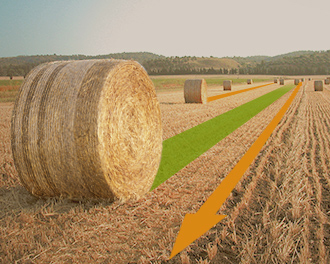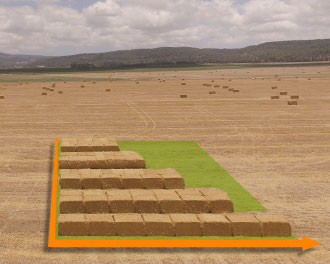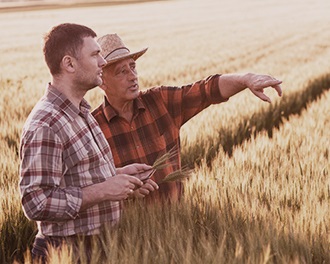Pit vs. Bale: Which Silage System Works Best on Your Farm?
2025
Silage is a cornerstone of livestock production across Ireland, and how you choose to store and preserve it has a… Read more
Silage is a cornerstone of livestock production across Ireland, and how you choose to store and preserve it has a big impact on forage quality, costs, and daily operations. For most farms, the two main options are the traditional silage pit (or clamp) and individually wrapped bales. Both systems have their place, and the “best” choice really depends on your scale, infrastructure, and priorities.
In this article, we’ll take a balanced look at the pros and cons of each system, highlighting the key factors that might sway your decision. While pits remain the go-to for many larger-scale farms, wrapped bales are becoming increasingly popular, and for good reason.
Silage Pits (Clamps): The Traditional Approach
Advantages
- Economies of Scale
- Silage pits are generally the most cost-effective option when dealing with very large volumes of forage.
- Filling and compacting a pit allows you to store thousands of tonnes of silage in one place, making them ideal for large dairy herds or mixed farms with high forage demand.
- Centralised Feeding
- With silage in one location, feeding becomes straightforward, particularly for TMR (total mixed ration) systems.
- The daily routine of removing and mixing silage is efficient when everything is in a single clamp.
- Lower Consumable Costs
- Unlike baled silage, there are no additional costs for film or netwrap per unit of forage.
- Once the clamp is constructed, ongoing material costs are minimal compared to bales.
Disadvantages
- Infrastructure Costs
- Silage pits require significant upfront investment in concrete walls, floors, and drainage.
- Planning and maintenance are ongoing considerations. Cracks, leachate management, and effluent regulations all add cost and complexity.
- Risk of Spoilage
- Poor sealing or slow feed-out rates can lead to aerobic spoilage at the face of the clamp.
- The larger the pit, the greater the risk of losing forage quality, particularly in warm or wet weather.
- Less Flexibility
- Silage pits tie you to a single storage site. You can’t easily transport or sell small batches of forage.
- They also make it harder to keep different cuts or forage types separate without multiple clamps (and the set-up costs that accompany them).
Wrapped Bales: Flexible and Farmer-Friendly
Advantages
- Flexibility in Scale
- Baled silage works just as well for small herds as it does for larger operations.
- You only need to make as many bales as required, so it suits farmers without the demand (or space) for a large clamp.
- Improved Forage Quality
- Each bale is individually sealed, reducing the risk of spoilage.
- This system preserves the nutritional value of smaller batches, and the forage stays fresher for longer once opened.
- Flexible Harvesting
- With bales, if all your grass isn’t ready at the same time, you can cut and store in stages.
- This staggered approach is harder with pit silage, which typically requires large machinery, labour, and a full clamp of crop ready at once.
- Cost Effectiveness with Quality
- While baled silage is sometimes seen as more expensive, that’s not always the case.
- If you target lighter, high-quality cuts, the cost per tonne of usable, high-feed-value silage can actually be lower; even when packaging is included.
- This can mean less waste, better animal performance, and more value from every acre.
- Easy Handling and Storage
- Wrapped bales can be stored almost anywhere: in a field, by a shed, or even sold directly from the stack.
- They can also be moved easily, making them attractive for farmers selling forage or contractors serving multiple farms.
- Separation of Crops
- Different cuts, fields, or forage types can be kept apart, giving you more control over rationing and quality.
- Especially useful when weather forces staggered cutting dates.
Disadvantages
- Higher Unit Cost
- Wrapping film and netwrap do add cost to each bale, and labour and machinery time per unit of forage can be higher at very large scales.
- That said, for smaller farms or targeted high-quality cuts, the economics are often more favourable than they first appear.
- Storage Space
- Bales take up more room than a compact clamp, so space planning is important.
- Poor stacking or storage on unsuitable ground can also risk punctures and spoilage.
- Waste Disposal
- Historically used net and film need to be collected and recycled separately, adding another job to an already busy workload.
- However, new products such as EZ Web®, have been designed to make net and film recovery easier, as they no longer require the two to be separated. The two can be recycled together and transformed back into new crop baling products, creating a circular economy that retains agri-plastic on the farm and out of landfill.
Key Considerations Before Choosing
- Herd Size and Forage Demand
- Large dairy units often lean towards pits because they can handle the volume efficiently.
- Smaller or mixed farms may find bales more practical and economical.
- Cashflow and Investment
- Pits demand upfront capital, but once in place, they offer low per-tonne costs.
- Bales spread costs out with each harvest; no big infrastructure outlay, but ongoing wrap expenses.
- Flexibility and Lifestyle
- Do you want forage you can move, sell, or store in smaller batches? Bales offer maximum flexibility.
- Do you prefer everything in one place with a streamlined feeding system? Pits might suit better.
- Forage Quality Goals
- If consistent, high-quality forage is your priority, individually wrapped bales reduce the risk of waste and aerobic spoilage.
- If bulk feeding efficiency is more important, pits deliver volume.



